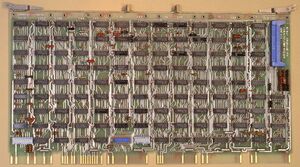Difference between revisions of "DUP11 synchronous serial line interface"
(Basic info) |
(No difference)
|
Revision as of 14:36, 21 March 2020
The DUP11 is an early synchronous serial line interface for the UNIBUS. Like the earlier DP11-A, it used programmed I/O (with separate receive and transmit interrupts) to transfer data; it was double-buffered for both input and output. It could operate in either half-duplex or full-duplex, at baud rates up to 9.6K bits/second.
Both byte-oriented (e.g. DDCMP, BISYNC) and bit-oriented (e.g. SDLC, HDLC) protocols were supported; a variety of CRC algorithms, depending on the[protocol in use on the line, were supported for error detection. The character length was 8 bits; the sync character was selectable under program control, as well as the modem control leads. It apparently supported idling (sending the sync character); the line could also be set to a mark condition when not transmitting characters. The DUP11 could also be set to discard additional incoming sync characters.
It was intended to interface to Bell 200 series modems (models 201, 208 and 209) and equivalents.
It was a hex card, the M7867; it plugged into an SPC slot. A Berg header on the card connected to a short flat cable which led off to a connector.
Registers
| Register | Abbreviation | Address |
|---|---|---|
| Receiver Status Register | RxCSR | 16xxx0 |
| Receiver Data Buffer Register (read only) | RxDBUF | 16xxx2 |
| Parameter Status Register (write only) | PARCSR | 16xxx2 |
| Transmitter Status Register | TxCSR | 16xxx4 |
| Transmitter Data Buffer Register | TxDBUF | 16xxx6 |
